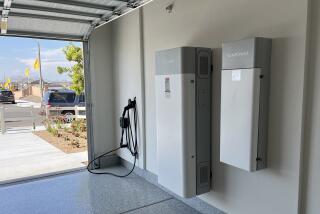This stove cooks -- but burns

In a makeshift laboratory equipped with little more than a battered chair and a cheap kitchen scale, inventor Rene Nuñez Suarez displays the contraption that has become his life’s obsession.
It’s a stainless-steel cooker that uses about 95% less fuel than conventional wood stoves, with minimal pollution. It would seem to be a can’t-miss technology in a country where millions still cook with wood and most forests have been destroyed.
The device has garnered Nuñez a prestigious environmental prize. It has earned him a U.S. patent. And it has won fans among some Salvadoran peasants who no longer spend a good chunk of their days hunting for firewood and the rest inhaling cooking smoke.
It has also wrecked Nuñez’s marriage, alienated two of his three children and swallowed his life savings. At 61, he lives with his mother to save on rent and drives a 1990 Kia. Nuñez knows some people think he’s a fool to have poured $2.5 million of his and his family’s money into his project with little to show for it.
“My ex-wife said: ‘Man, you are an idiot. Poor people have no money. They are not going to buy your stoves,’ ” he said. “She was right.”
Nuñez gambled that the government or nonprofit groups would finance production of the appliances to distribute to low-income people. But Salvadoran officials so far have shown scant interest in his invention. Environmental groups have offered praise but little financial backing.
Nuñez wonders if he’d get more respect if he hailed from Silicon Valley instead of this tiny Central American nation, where he toils in obscurity at a small private university in the capital. His “Advanced Combustion Laboratory of Menlo Park” -- he named it in honor of Thomas Edison -- is a converted storeroom fitted with a single fluorescent bulb. His annual budget is $10,000. Still, he perseveres.
Nuñez is convinced that his combustion method can save trees and reduce greenhouse gases. He figures the technology can be adapted to any fuel and put to industrial uses such as electricity generation. But saving the planet has become secondary to a more personal quest: winning back the love of his kids.
“If I could eliminate those emissions, then my children would be proud of me,” Nuñez said. “That became the main motive of my invention. To let them know that I was right.”
Nuñez married into one of the most powerful families in El Salvador, for whose business he designed industrial equipment. They helped him start his own small business building computer voltage regulators and power supplies. He drove a Range Rover and piloted a Piper Dakota plane. Why risk it all on a stove for the poor?
Intellectual curiosity is part of it. So are hubris and naivete. Then there are the words of the eccentric 20th century inventor Nikola Tesla, one of Nuñez’s idols: “Science is but a perversion of itself unless it has as its ultimate goal the betterment of humanity.”
It all started in the mid-1990s when a friend asked Nuñez to write a chapter on energy resources for a book about El Salvador’s natural history. A voracious reader and compulsive tinkerer, Nuñez said he was stunned to find that 65% of his nation’s 7 million people relied on wood for fuel.
In fact, half the planet cooks and heats much the way their ancestors did using solid fuels, according to the World Resources Institute, a Washington-based environmental think tank.
The environmental and health costs are staggering. Indoor pollution from cooking fires kills an estimated 1.6 million people a year worldwide, mostly women and children. Deforestation is a major source of carbon emissions and exacerbates both flooding and drought. The problem is particularly acute in El Salvador, where the nation’s primary watershed is threatened by deforestation.
For Nuñez, a tall, aristocratic-looking engineer who speaks English with a vaguely British accent acquired during his student days in northern England, it all seemed an appalling waste.
“I thought: ‘Well, if we don’t fix that, we are going to convert this country into a complete desert,’ ” he said.
Petroleum-poor El Salvador has no ready replacement for wood. What was needed, Nuñez reasoned, was an ultra-efficient wood-burning cooker. Environmental groups have been pushing such projects for decades. Most involve the use of low-cost insulating materials such as mud or ceramic.
Nuñez dismisses these as “stone-age” technologies. He surmised that the key was a more efficient combustion chamber to get the combination of air, fuel and temperature just right. With the computer electronics business fast migrating to China, he decided to ditch that enterprise and reinvent his company to produce high-tech wood stoves.
Never mind that his wife wasn’t crazy about the idea and the couple had three kids to support. Or that Nuñez knew little about combustion. With the help of textbooks and countless experiments, he slowly taught himself and his 10 employees.
Ingenuity runs in the family. Nuñez’s 92-year-old father, Ernesto, is a former surgeon who designed some of his own medical instruments.
“Rene always had a spirit for invention, moved by curiosity about things,” Ernesto said.
Longtime friend Janet Parr, a Brit who met Nuñez when he was studying at the University of Salford, remembers that the Central American was eager to try chopsticks for the first time. She described him as fun-loving and warm, yet relentless when pursuing a goal.
“He is a very stubborn and difficult man,” she said. “He’ll do it his way or not at all.”
Nuñez’s early efforts flopped. An aluminum version of the stove melted into a smoldering heap. In 1997 he came up with a working prototype he dubbed the Turbococina, or Turbostove. He would spend years perfecting it.
The device consists of a metal work table fitted with two 6-inch-high, 6-inch-wide stainless steel cylinders, spaced about a foot apart and rigged with air injectors and electric fans underneath. Finger-sized slivers of wood are fed into small openings in the sides of the cylinders. Pots and pans balance on top of these metal silos, which are essentially raised burners.
At first glance, the cooker looks like a crude science fair entry. Nuñez can’t be bothered with aesthetics. He said his stove was really a “reactor” and that its beauty lay within. The peak temperature in the combustion chamber is about 970 degrees Celsius. He said that was 500 to 600 degrees cooler than that of some industrial combustion processes. The lower temperature saves on fuel and reduces emissions. But he won’t give specifics on how he managed it. “That’s my secret,” he said, the smile retreating from his face. “It cost me blood and suffering to make that stove. . . . I don’t want anyone stealing my idea.”
Nuñez said the Turbococina used 95% less fuel than a typical wood stove. Testing at a Canadian lab showed that emissions of carbon monoxide and nitrogen oxide were negligible, he added. Bill Pearson, a research engineer who did the testing, said the Turbococina showed “impressive” energy efficiency. He could not recall that it was tested for emissions, though he said it produced very little visible smoke.
San Salvador environmental economist Diego Salcedo said the stove represented a significant advance. He has been trying to help Nuñez land funding for large-scale production of the Turbococina, so far with no success. He said El Salvador’s poor reputation in scientific circles hadn’t helped.
“There is always disbelief,” Salcedo said. “They think: ‘How could a Salvadoran have invented something so wonderful?’ ”
All Adelina Erazo knows is that the Turbococina means less time scavenging for fuel and more money in her pocket. The 33-year-old widow, who lives in the countryside east of the capital, said she no longer rose before dawn to make the 12-mile trek to forage for wood. That leaves more time to care for her three young girls and to earn money selling her thick, chewy Salvadoran-style tortillas. The girls are coughing less. Meals can be prepared more quickly.
She got the stove two years ago, courtesy of a nonprofit that paid for some field testing of the appliance. Bustling about her dirt-floor kitchen preparing lunch on the device, Erazo said the cooker wasn’t perfect. She wishes it had three burners instead of two. She said pots could topple from the cylinders if she was not careful. And when the electricity goes out, she can’t use the Turbococina because it needs the fans to move air into the combustion chambers.
Still, she said there was no question that it had made her life easier. She pointed with satisfaction at a heap of tree limbs piled outside her rickety dwelling, a windfall from a storm. She figured that supply might last 10 months -- if she didn’t get robbed. Wood has gotten so expensive and scarce in her area that people steal it from one another.
“It’s an endless struggle,” she said of the quest for fire.
In 2002, the Paris-based International Energy Agency, through its Climate Technology Initiative, awarded Nuñez its Climate Technology Leadership Award for his invention. He received U.S. Patent No. 6,651,645 B1 the following year. But financial success has eluded him.
Green groups aren’t lining up like he thought they would to fund his technology. He has won occasional grants to manufacture a few stoves for poor families such as the Erazos. A contractor makes them for him for $325. His own company can’t do it because he no longer has a company or employees. Nuñez is broke.
He said his ex-wife, who declined to be interviewed for this article, took most of the couple’s assets as part of a bitter divorce prompted by his obsession with the Turbococina. A friend pulled some strings to get him a research post at the Universidad Francisco Gavidia after he exhausted his personal savings on the stove. Nuñez said his daughter and oldest son had broken ties with him because they believed he sacrificed family and fortune for a quixotic dream.
“They think I’m crazy,” he said softly. “I have to show them that I’m successful before they’ll talk to me again.”
His middle child, Mauricio, remains devoted. The 27-year-old finance administrator said Nuñez was a loving, patient father who came up with his own method to teach Mauricio to read before he went to kindergarten. Now living in Germany, Mauricio said he was sure his dad had developed something significant. But he said Nuñez had lost so much to his own invention that he had become paralyzed in the commercialization effort, unsure of whom to trust and fearful of blowing his one shot at redemption.
Even admirers say Nuñez’s cautiousness is largely to blame for the fact that his cooker is still locked in the lab. American environmental consultant Lilia Abron, who promotes green technology in the developing world, said she could sell plenty of Turbococinas if Nuñez would just get them into mass production.
She traveled to El Salvador to view a prototype last year and was thrilled with the stove’s efficiency and minimal smoke. She said she urged the inventor to hook up with a major appliance manufacturer to lower the cost, but to no avail.
“The market is there,” said an exasperated Abron, a chemical engineer and founder of Washington-based Peer Consultants. “He just won’t let it go.”
Nuñez remains wary. He said he had come up with a natural gas version of the Turbococina that had huge commercial potential. But he has no money for full-scale testing, and prospective partners are asking for too big a share of his invention.
Parr said she wasn’t sure if her old friend would ever recoup what he had invested.
“He has lost his wife and his children,” she said. “He has paid a really high price.”
Times staff writer Alex Renderos contributed to this report.






